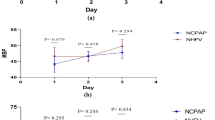Abstract
We attempted to determine the plasma endothelin-1-like immunoreactivity (ET-1) levels and to evaluate its physiological significance in 29 neonates: 5 with respiratory distress syndrome (RDS), 3 with transient tachypnoea of the newborn (TTN), 4 with neonatal asphyxia, 5 with bronchopulmonary dysplasia (BPD) following RDS, 7 healthy preterm infants and 5 healthy full-term infants. Plasma ET-1 levels in infants with RDS were significantly higher than those in healthy full-term infants through the 1st week of life. Plasma ET-1 levels in infants with neonatal asphyxia were high on the first 2 days of life and then gradually decreased to those of healthy full-term infants. Plasma levels in infants with TTN were the same as those in healthy full-term infants. Plasma ET-1 levels in infants with BPD were high when compared with those in healthy preterm infants during the first 2 months of life. This study showed that plasma levels were markedly elevated for a long time in the infants with respiratory distress. We speculate that plasma ET-1 may be a specific marker for pulmonary endothelium injury in infants with respiratory distress.
Similar content being viewed by others
Abbreviations
- BPD:
-
bronchopulmonary dysplasia
- ET-1:
-
endothelin-1-like immunoreactivity
- RDS:
-
respiratory distress syndrome
- TFA:
-
trifluoroacetic acid
- TTN:
-
transient tachypnoea
References
Ando K, Hirata Y, Shichiri M, Emori T, Marumo F (1989) Presence of immunoreactive endothelin in human plasma. FEBS Lett 245:164–166
Ando K, Hirata Y, Takei Y, Kawakami M, Marumo F (1991) Endothelin-1-like immunoreactivity in human urine. Nephron 57:36–39
Arant BS Jr (1981) Nonrenal factors influencing renal function during the perinatal period. Clin Perinatol 8:225–240
Berma W Jr, Yabek SM, Dillon T, Burstein R (1982) Evaluation of infants with bronchopulmonary dysplasia using cardiac catheterization. Pediatrics 70:708–711
Brownlee JR, Beekman RH, Rosenthal A (1988) Acute hemodynamic effects of nifedipine in infants with bronchopulmonary dysplasia and pulmonary hypertension. Pediatr Res 24: 186–190
Hirata Y, Itoh K, Ando K, Endo M, Marumo F (1989) Plasma endothelin levels during surgery. N Engl J Med 14:1686
Isozaki-Fukuda Y, Kojima T, Hirata Y, Ono A, Sawaragi S, Sawaragi I, Kobayashi Y (1991) Plasma immunoreactive endothelin-1 concentration in human fetal blood: Its relation to aspyhxia. Pediatr Res 30:244–247
Klaus MH, Fanaroff AA (1986) Care of the high risk neonate, 3rd edn. Saunders, Philadelphia, pp 410
Koch G, Wendel H (1968) Adjustment of arterial blood gases and acid base balance in the normal newborn infant during the first week of life. Biol Neonate 12:316–361
MacCumber MW, Ross CA, Glaser BM (1989) Endothelin: visualization of mRNAs by in situ hybridization provides evidence for local action. Proc Natl Acad Sci USA 86:7285–7289
Madeddu P, Yang XP, Anania V, Troffa C (1990) Efficacy of nifedipine to prevent systemic and renal vasoconstrictor effects of endothelin. Am J Physiol 259:F304–311
Rakugi H, Tabuchi Y, Nakamaru M, Nagano M, Higashimori K, Mikami H, Ogihara T, Suzuki N (1990) Evidence for endothelin-1 release from resistance vessels of rats in response to hypoxia. Biochem Biophys Res Commun 169:973–977
Shirakami G, Nakao K, Saito Y, Magaribuchi T (1991) Acute pulmonary alveolar hypoxia increases lung and plasma endothelin-1 levels in conscious rats. Life Sci 48:969–976
Sobonya RE, Logvinoff MM, Taussig LM, Theriaut A (1982) Morphometric analysis of the lung in prolonged bronchopulmonary dysplasia. Pediatr Res 16:969–972
Suzuki N, Matsumoto, H, Kitada C, Kimura S, Miyauchi T, Fujino M (1990) A sandwich-type enzyme immunoassay to detect immunoreactive big-endothelin-1 in plasma. J Immunol Methods 127:165–170
Yanagisawa M, Kurihara H, Kimura S, Tomobe Y, Kobayashi M, Mitsui Y, Yazaki Y, Goto K, Masaki T (1988) A novel potent vasoconstrictor peptide produced by vascular endothelial cells. Nature 332:411–415
Author information
Authors and Affiliations
Rights and permissions
About this article
Cite this article
Kojima, T., Isozaki-Fukuda, Y., Takedatsu, M. et al. Plasma endothelin-1 like immunoreactivity levels in neonates. Eur J Pediatr 151, 913–915 (1992). https://doi.org/10.1007/BF01954129
Received:
Accepted:
Issue Date:
DOI: https://doi.org/10.1007/BF01954129




